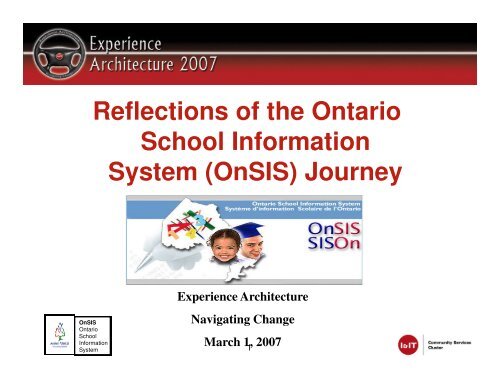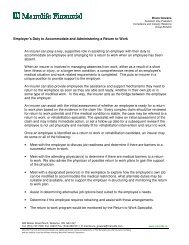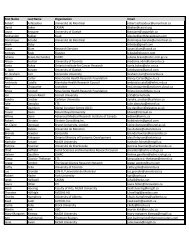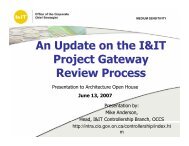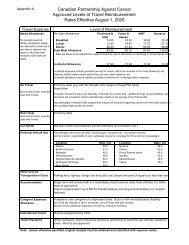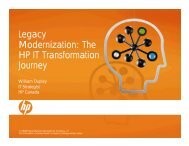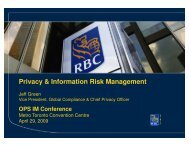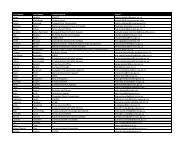OnSIS - Verney Conference Management
OnSIS - Verney Conference Management
OnSIS - Verney Conference Management
You also want an ePaper? Increase the reach of your titles
YUMPU automatically turns print PDFs into web optimized ePapers that Google loves.
Reflections of the Ontario<br />
School Information<br />
System (<strong>OnSIS</strong>) Journey<br />
Experience Architecture<br />
Navigating Change<br />
<strong>OnSIS</strong><br />
Ontario<br />
School<br />
Information<br />
System 1<br />
March 1, 2007
<strong>OnSIS</strong><br />
Ontario<br />
School<br />
Information<br />
System 2
<strong>OnSIS</strong><br />
The goal of <strong>OnSIS</strong> is to implement a<br />
web-enabled system for streamlining<br />
and improving the collection,<br />
management and reporting of<br />
elementary and secondary educationrelated<br />
data<br />
<strong>OnSIS</strong><br />
Ontario<br />
School<br />
Information<br />
System 3<br />
.
Data<br />
<strong>OnSIS</strong> Overview<br />
<strong>Management</strong> Before<br />
OCT Boards EQAO<br />
Ontario College<br />
of Teachers<br />
Education Quality &<br />
Accountability Office<br />
Schools<br />
Statistics<br />
Canada<br />
The Ministry of Education<br />
TSR SIS BSID CS BR MR Financial Other<br />
Teaching<br />
Staff<br />
Report<br />
Student<br />
Information<br />
System<br />
Board/School<br />
Identification<br />
Data<br />
Course/<br />
Class<br />
Enrolment<br />
Board<br />
Report<br />
School<br />
Report<br />
Stars<br />
Students<br />
and<br />
Regional<br />
Settings<br />
– Manual support required<br />
– Duplicate / Inconsistent Information<br />
<strong>OnSIS</strong><br />
Ontario<br />
School<br />
Information<br />
System 4<br />
–Lengthy data collection processes<br />
– Reliance on outdated software<br />
and discontinued vendor support
Data<br />
<strong>Management</strong> After<br />
The Ministry of Education<br />
<strong>OnSIS</strong> Overview<br />
ESDW<br />
(Elementary Secondary Data Warehouse)<br />
<strong>OnSIS</strong><br />
Schools<br />
Boards<br />
<strong>OnSIS</strong><br />
Ontario<br />
School<br />
Information<br />
System 5<br />
EQAO<br />
OCT<br />
Others
<strong>OnSIS</strong> Overview<br />
MISA (Managing Information for Student Achievement)<br />
Overview<br />
ESS<br />
OEN<br />
Unique identifier<br />
for students<br />
Secure<br />
access to<br />
applications<br />
<strong>OnSIS</strong><br />
41<br />
Depersonalization<br />
Supporting<br />
evidence-based<br />
decision making<br />
ESDW<br />
Data collection<br />
and<br />
management<br />
<strong>OnSIS</strong><br />
Ontario<br />
School<br />
Information<br />
System 6<br />
School Board Profiles<br />
Public<br />
access to<br />
information
<strong>OnSIS</strong> Overview<br />
MISA and <strong>OnSIS</strong> Corporate<br />
Strategies<br />
• Information <strong>Management</strong><br />
• Legacy Renewal Strategy<br />
• Business Intelligence, Evidence based<br />
Decision Making<br />
• Horizontal Collaboration Opportunities<br />
<strong>OnSIS</strong><br />
Ontario<br />
School<br />
Information<br />
System 7
<strong>OnSIS</strong> Overview<br />
Project Approach<br />
• Strong business leadership & participation<br />
• Aligned with Corporate EA Framework<br />
• EA Process Conformance<br />
• Checkpoints 1, 2, 3 Completed<br />
<strong>OnSIS</strong><br />
Ontario<br />
School<br />
Information<br />
System 8
<strong>OnSIS</strong> Overview<br />
<strong>OnSIS</strong> Business - Stakeholders<br />
IMG<br />
Ministry<br />
Schools (5,600)<br />
Boards (105)<br />
Other Organizations<br />
- Education Quality and Accountability Office<br />
- College and Universities Application Centres<br />
- Ontario College of Teachers<br />
11,000 users<br />
<strong>OnSIS</strong><br />
Ontario<br />
School<br />
Information<br />
System 9
<strong>OnSIS</strong> Overview<br />
Objective & Functions<br />
To provide the data required to facilitate policy development, business planning,<br />
tracking, monitoring and accountability at the ministry, board and school levels.<br />
Data Collection<br />
- Validation<br />
- Scheduling<br />
- Tracking<br />
Data <strong>Management</strong><br />
- Inquiry<br />
- Extracts and Reports<br />
- Archiving<br />
- Metadata Repository<br />
<strong>OnSIS</strong><br />
Ontario<br />
School<br />
Information<br />
System 10<br />
Security/Roles Assignment
Corporate or Cluster<br />
Architecture<br />
Governance<br />
Checkpoint 0<br />
Project Initiation<br />
Meets criteria for Corporate<br />
Architecture Review<br />
Corporate<br />
Architecture Governance<br />
Waterfall<br />
Iterative<br />
Business Architecture<br />
(Rows 1 & 2)<br />
Logical Architecture<br />
(Row 3)<br />
Checkpoint 1<br />
Domain Working<br />
Checkpoint 2<br />
Group or<br />
Multidisciplinary<br />
Checkpoint 2<br />
Review<br />
Inception<br />
Business Architecture<br />
(Rows 1 & 2)<br />
Prioritized list of all business<br />
use cases in project scope<br />
Elaboration<br />
(Rows 1 & 2 if necessary)<br />
(Rows 3, 4 & 5 for all<br />
selected Use Cases)<br />
Technology Architecture<br />
(Row 4)<br />
Detailed Representations<br />
(Row 5)<br />
Checkpoint 3 Checkpoint 3<br />
Checkpoint 4<br />
<strong>OnSIS</strong><br />
Ontario<br />
School<br />
Post-Implementation<br />
Information<br />
Review<br />
System 11<br />
Construction<br />
(Rows 3, 4 & 5 for<br />
remaining Use Cases)<br />
Transition
<strong>OnSIS</strong><br />
Ontario<br />
School<br />
Information<br />
System 12<br />
Zachman Framework
CSC Architectural Review<br />
Process<br />
<strong>OnSIS</strong><br />
Ontario<br />
School<br />
Information<br />
System 13
Well-architected systems realize some or all of<br />
these benefits:<br />
• Developers can build and maintain loosely coupled components more independently,<br />
and even completely replace old components with new technologies without breaking<br />
clients that depend upon them for services.<br />
• Clear definitions of responsibilities often answer questions like "where should I put<br />
this functionality" before they are even asked, simplifying life for those who build<br />
components or try to understand them later.<br />
• Common design patterns, tools, hardware and software platforms allow developers to<br />
move from one system to another and apply their current skills effectively.<br />
• Applications built to a consistent architecture are more easily integrated with each<br />
other to share data and functionality.<br />
• Standards-based technologies are more easily integrated with external business<br />
partners and commercial "off the shelf" products.<br />
• Careful design of the application and the infrastructure yield high availability and<br />
performance.<br />
• The long-elusive goal of reusable components is achievable.<br />
• Robust systems that can survive partial failure.<br />
• Robust designs that can survive extension, adaptation, requirements changes,<br />
platform changes, etc.<br />
<strong>OnSIS</strong><br />
Ontario<br />
School<br />
Information<br />
System 14
Value Architecture Added:<br />
Access to Architecture Experts<br />
• Consulting architect participated in design sessions and<br />
reviews, provided direction and advice<br />
Consulting architect consulted with other architecture<br />
professionals during the design process to provide additional<br />
direction<br />
Architecture experts became Trusted Advisors throughout the<br />
design process<br />
<strong>OnSIS</strong><br />
Ontario<br />
School<br />
Information<br />
System 15
Value Architecture Added:<br />
Advice on implementation of<br />
Zachman Framework<br />
• Zachman Framework is generic - it can be implemented in a<br />
variety of ways<br />
The OPS Architecture Groups provided the project team an<br />
understanding of the specific approach to be used within<br />
OPS<br />
Specific approach included checkpoints, templates,<br />
examples, advice from experts.<br />
<strong>OnSIS</strong><br />
Ontario<br />
School<br />
Information<br />
System 16
Value Architecture Added:<br />
Identified Common Components<br />
that were candidates for re-use<br />
by <strong>OnSIS</strong> Project<br />
• The OPS Architecture group was involved in the design<br />
from the early states - they had a clear understanding of<br />
the requirements.<br />
Based on their understanding, they helped to identify<br />
appropriate common components for re-use<br />
<strong>OnSIS</strong><br />
Ontario<br />
School<br />
Information<br />
System 17
Common Components –<br />
multiple uses within <strong>OnSIS</strong><br />
application<br />
Component Name<br />
Access Privileges<br />
Data<br />
Activity Logger<br />
Batch User Input<br />
Data Validation<br />
Messaging<br />
Number/ Code<br />
Generator<br />
Output File Generator<br />
Retrieve LDAP User<br />
and Role Information<br />
Scheduled Task<br />
Initiator<br />
<strong>OnSIS</strong><br />
Ontario<br />
School<br />
Information<br />
System 18
Common Components –<br />
used by <strong>OnSIS</strong> application and<br />
Other Applications<br />
ESS (ESIP Security System)<br />
• Based on PMI A&A service from CSB<br />
• User is authenticated and authorized to<br />
access <strong>OnSIS</strong> application through ESS<br />
• The permissible roles and User Groups<br />
(Types) for every user are identified to ESS<br />
via LDAP<br />
<strong>OnSIS</strong><br />
Ontario<br />
School<br />
Information<br />
System 19<br />
• ESS is also used by OEN, ASA, ESDW<br />
applications
Common Components –<br />
used by <strong>OnSIS</strong> application and<br />
Other Applications<br />
Address Validation Common Component<br />
• This component validates address<br />
information entered by the users<br />
• Address information is validated based on<br />
source data provided by Canada Post<br />
• Web based component that is accessed by<br />
the <strong>OnSIS</strong> servers via standard internet<br />
protocol<br />
<strong>OnSIS</strong><br />
Ontario<br />
School<br />
Information<br />
System 20
Common Components –<br />
used by <strong>OnSIS</strong> application and<br />
Other Applications<br />
Ontario Education Number application<br />
• This component provides a single unique identifier<br />
(“OEN”) for all Ontario students<br />
• All student data entered into <strong>OnSIS</strong> is first<br />
validated against the OEN database to ensure the<br />
accuracy of OEN and student bio data.<br />
• Web based component that is accessed by the<br />
<strong>OnSIS</strong> servers via standard internet protocol<br />
<strong>OnSIS</strong><br />
Ontario<br />
School<br />
Information<br />
System 21
Value Architecture Added:<br />
Facilitated adherence to Corporate/<br />
EA guidelines and standards<br />
• Information Modeling Handbook (IMH)<br />
•Infrastructure Component Catalogue (ICC)<br />
•Ontarians with Disability Act (ODA) – Section<br />
Six<br />
•Artifact templates<br />
<strong>OnSIS</strong><br />
Ontario<br />
School<br />
Information<br />
System 22<br />
• TRA and PIA completed
Results: Application Development<br />
Main Technologies:<br />
• Windows Server (clustering and load balancing)<br />
• IIS<br />
• .NET<br />
• Oracle (clustering and load balancing)<br />
• Crystal Reports<br />
<strong>OnSIS</strong><br />
Ontario<br />
School<br />
Information<br />
System 23
Results: Application Development<br />
• Number of Web pages: 2200+<br />
• Number of Database Tables: 460<br />
• Number of Business Rules: 5000+<br />
• Lines of Code: 2,000,000+<br />
<strong>OnSIS</strong><br />
Ontario<br />
School<br />
Information<br />
System 24
CISCOSYSTEMS<br />
3Com<br />
hp StorageWorks 41 0<br />
Physical Deployment<br />
Model (production)<br />
Internet<br />
Internet<br />
Web Client<br />
EDU/ TCU<br />
DMZ<br />
("Gb E" LAN)<br />
2 Dell<br />
PowerEdge 4400<br />
Web Servers<br />
with<br />
Load Balancers<br />
EDU/ TCU<br />
and GetAccess<br />
Firewall<br />
Runtime<br />
Checkpoint v4.1<br />
EDU/ TCU<br />
Domain-Backend Subnet<br />
("GB E" LAN)<br />
MSA 1000<br />
Corporate<br />
Firewall<br />
EDU/ TCU<br />
Edge<br />
Router<br />
EDU/ TCU<br />
Firewall<br />
Checkpoint<br />
v4.1 Network Intrusion<br />
Detection System<br />
ISS Real Secure v6.5<br />
GONET<br />
<strong>OnSIS</strong><br />
LDAP<br />
Ontario<br />
Server<br />
School<br />
(iSERV)<br />
Information<br />
System 25<br />
EDU/ TCU<br />
Domain-<br />
Middleware<br />
Subnet<br />
("GB E" LAN )<br />
3 X Compaq ProLiant ML370 G3<br />
Database Servers with SAN and<br />
Load Balancers<br />
EDU/ TCU<br />
Internal Router<br />
Reporting<br />
Server<br />
Internal Web Client<br />
subject to auth. and authorization<br />
Component<br />
Services Server<br />
3 Dell PowerEdge<br />
App Servers<br />
Metadata<br />
Repository/ Data<br />
Extract Server
Results: Application Deployment<br />
• <strong>OnSIS</strong> Release 1 deployed to production December 2004<br />
• <strong>OnSIS</strong> Release 2 deployed to production January 2006<br />
• <strong>OnSIS</strong> Release 3 deployed to production September 2006<br />
• <strong>OnSIS</strong> Release 5-1 planned for deployment to production<br />
Spring 2007<br />
• <strong>OnSIS</strong> Release 5-2 planned for deployment to production<br />
Summer 2007<br />
• <strong>OnSIS</strong> Release 4-1 and 4-2 planned for deployment post<br />
Summer 2007 (reprioritized after R5-1, 5-2)<br />
<strong>OnSIS</strong><br />
Ontario<br />
School<br />
Information<br />
System 26
Results: Application Throughput<br />
• User Base as of Feb 2007: 7200<br />
• Number of Students: 2,377,809<br />
• Number of Educators: 100,000<br />
• Over 96% of submissions completed for 05/06 academic year<br />
• Peak Number of Web page hits per day: 435,277<br />
• Average Batch Files Processed Per Day: 700<br />
• Average Reports Processed Per Day; 10,000<br />
• Average Number of Database Calls Per Hour: 3,769,295<br />
<strong>OnSIS</strong><br />
Ontario<br />
School<br />
Information<br />
System 27
Challenges: Application<br />
Enhancements<br />
• During the first 12 months of student data collection,<br />
numerous urgent application enhancements had to be done<br />
due to changes in the business requirements<br />
• The risk was that these enhancements could a negative impact<br />
on overall application stability due to the speed at which they<br />
needed to be completed<br />
• Due in large part to the componentized nature of the <strong>OnSIS</strong><br />
design, enhancements were completed and deployed to<br />
production with minimal negative impact to the overall<br />
application health.<br />
<strong>OnSIS</strong><br />
Ontario<br />
School<br />
Information<br />
System 28
Challenges: Application Performance<br />
• During the first 12 months of student data collection, users’ usage<br />
patterns were analysed to determine where the potential performance<br />
bottlenecks<br />
• Numerous potential bottlenecks were identified<br />
• Performance improvements included database tuning, server<br />
configuration tuning, application code tuning<br />
• The risk was that these the implementation of these improvements<br />
could have a negative impact on overall application stability due to<br />
the speed at which they needed to be completed<br />
• Due in large part to the componentized nature of the <strong>OnSIS</strong> design,<br />
performance improvements were completed and deployed to<br />
production with minimal negative impact to the overall application<br />
health.<br />
<strong>OnSIS</strong><br />
Ontario<br />
School<br />
Information<br />
System 29
Challenges: New Release Development<br />
• During 2006, while Releases 1,2,3 have been in<br />
full production, Release 4 and 5-1 have been in<br />
development<br />
• Release 4 and 5-1 development teams have been<br />
able extend the existing functionality in order to<br />
meet the business requirements with minimal rework<br />
to existing <strong>OnSIS</strong> code.<br />
• During 2007, the Community Services I&IT Cluster<br />
will take full custodianship of all <strong>OnSIS</strong> source<br />
code. While extremely challenging, it is expected<br />
that this take over will go smoothly<br />
<strong>OnSIS</strong><br />
Ontario<br />
School<br />
Information<br />
System 30
Challenges: Hardware/Software<br />
Failures<br />
• During 2006, the <strong>OnSIS</strong> application experienced<br />
several hardware and/or software failures that<br />
would have crippled an application that did not<br />
have redundancies build into the architecture.<br />
• <strong>OnSIS</strong> was able to recover from these failures,<br />
seamlessly in most cases.<br />
<strong>OnSIS</strong><br />
Ontario<br />
School<br />
Information<br />
System 31
Recommendations to maximize the<br />
value provided by Architecture<br />
• Engage Ministry Architecture groups at the<br />
inception of and throughout the design<br />
process<br />
• Collaborate with Ministry Architecture<br />
groups as partners, rather than gatekeepers<br />
or auditors.<br />
• Ensure the project's design team includes<br />
highly skilled architecture resources<br />
<strong>OnSIS</strong><br />
Ontario<br />
School<br />
Information<br />
System 32
Thank You!<br />
Questions?<br />
<strong>OnSIS</strong><br />
Ontario<br />
School<br />
Information<br />
System 33


